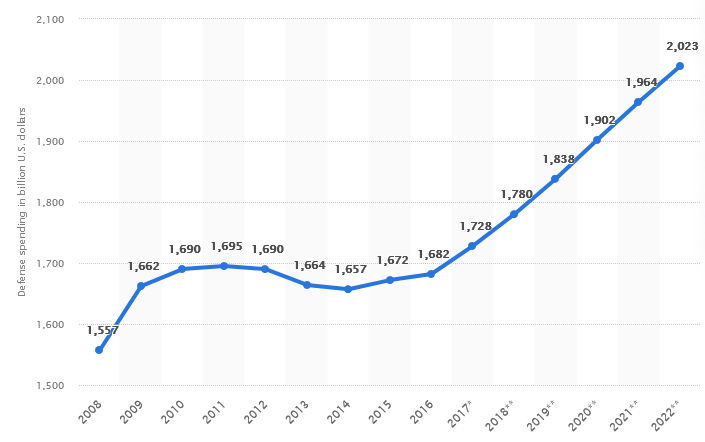The defense industry is a major center of innovation and industrial capacity. It is also a controversial industry, as it ultimately makes money from geopolitical tensions, violence, and wars. This is why defense stocks are often grouped with “sin stocks” like tobacco and gambling stocks.
Nevertheless, the need for the military is not going away anytime soon, as the war in Ukraine shows us. Any hopes for Fukuyama’s “End of history” are probably just that, hopes. The unfortunate truth is that national sovereignty and freedom are mostly earned – and often challenged – at gunpoint.
Only the dead have seen the end of war.
Defense spending worldwide – Source: Statista
Industry Structure
Over the last three decades, we have seen a consolidation trend in the industry, especially in the US defense industry. You can read more in this article about how many of the US suppliers to the military are now merged into just 5-6 megacorporations:
Most non-Western manufacturers are state-owned companies that are closed to investors. Beyond the US, other NATO countries and US allies have publicly listed defense companies, for example:
- France: Dassault, Airbus, and Thales
- Germany: Reinhmetall, Thyssenkrupp and MBDA
- UK: BAE Systems
- Italy: Leonardo
- Sweden: Saab.
The defense industry actually covers a multitude of subsectors, often categorized by technology:
- Aerospace (planes, satellites, missiles,…)
- Cyberdefense, Telecom, and AI
- Weapons (ammunition, artillery, guns, …)
- Vehicles (armored carriers, tanks, …)
- Maritime (ships, submarines, …)
- Logistics & Software
- Personal equipment (body armor, shoes, …)
- Sensors (optics, radars, etc…)
Because of consolidation, some products in these subsegments are either the monopoly of one company or a small oligopoly with 2-4 companies controlling the market, The more expensive the equipment, the smaller the number of suppliers usually is.
This gives the primary suppliers strong pricing power and a powerful moat, especially in times of crisis when government rushes to increase defense spending.
The Case for Defense Investing
One simple reason to invest in military spending is geopolitics. Russia comes to mind, but also Iran and North Korea, and, more importantly, China. It seems an arms race has started between the US and China and will last for a while. Just to give you some perspective, here is some of the most recent news about increases in military spending:
None of these budget increases have yet translated into increased earnings for defense firms. However, it could be said that the stock prices are already reflecting some of these increases.
Si vis pacem, para bellum
(If you want peace, prepare for war)
Defense Industry Advantages
The other reason for investing in this sector is the actual business case.
This is an industry with a strong focus on innovation, including technologies that can later be licensed to the civilian industry and find more peaceful applications. It is also focused on the long term and is known to be a great capital compounder.
The sector also has multiple strong moats relying on different forces:
- Substitution costs: armies often use the same basic design for several decades, upgrading it as new technology emerges: for example, the Abrams US main battle tank from General Dynamics was first designed in the 1970s.
- Regulations and compliance: procurement procedures from ministries of defense are notoriously complex and give large, established firms an advantage. It is also a factor of why lobbying and long-term relations with decision-makers (politicians and generals) can make a difference.
- Intellectual Property: trade secrets and patents are hard-to-replicate advantages favoring the incumbents.
- Unique manufacturing infrastructures. If a company has built nuclear submarines for decades, it will be almost unbeatable at this activity and might be the only one with the right shipyard and certifications to do so.
All of these factors protect established defense firms from competition.
Assessing Defense Companies
Here are some key points to consider when assessing defense companies:
National Profile
The first thing to consider when looking at a defense company is its nationality. As it will mostly depend on public spending, we must accurately assess the country’s finances and politics.
The ideal country for investors in defense would have a profile like this:
- Spends at least 1.5% to 2% of its GDP on its military budget and plans to increase it.
- Has a society-wide consensus on the necessity of military spending.
- A healthy economy and low or no deficit, with a reasonable debt load (meaning the current spending can be sustained).
- The 10 years geopolitical horizon with neighboring or competing powers is tense, implying no reduction in the military budget soon (sadly, this might be less relevant today, as it might be true for almost all countries).
Exports can be important contributors to a defense company’s bottom line. Export contracts often go on for years and include lucrative spare parts and service contracts. Still, considering how politically and diplomatically sensitive defense contracts tend to be, excessive reliance on exports might be tricky and unpredictable.
A large and healthy national economy supporting its defense champions makes for a safer investing case, with export contracts as a welcome bonus.
Business Profile
While the industry as a whole can be attractive, individual companies are a different matter. Competitive position is very important here. A good defense company should have several successful designs which have been adopted by multiple countries.
It should also be recognized as an innovator, and its new designs to be both cost-efficient and reliable. For example, recent issues with the development of (too?) complex and expensive weapons like the F-35 fighter jet or the Puma tank should be red flags, in my opinion.
Lastly, the company should be active in “trendy” sectors that reflect a growing military need (and spending). For example, sectors like space, cyber defense & AI, drones & air defense, and hypersonic missiles.
Valuation
Because the defense industry is relying on relatively constant military spending, we should not base valuation by counting on explosive growth. This means that even in the context of expected increasing militarization, valuation should still incorporate a margin of safety.
This is especially true as part of the past 2-3 decades’ growth has come from consolidation and cost optimization. With fewer targets for M&A, this might not be true in the future.
In addition, some supply problems for Ukraine might indicate that cost rationalization has been pushed too far, for example, too little spare capacity in ammunition manufacturing or the production of older designs interrupted and hard to restart from scratch.
In my opinion, this indicates that the peacetime era of ever-increasing ROIC is probably over.
So P/E ratio should be ideally in the single digits or the 10-15 range at most, not higher. Similarly, conservative ratios for price-to-free cash flow or price-to-sales should be preferred as well.
Portfolio Construction
It can be difficult for investors with no deep knowledge of the military to decide which stock to pick. Is this new tank plane a technological marvel or a breaking-down mess?
For this reason, I would suggest that amateur defense investors should stick to a panel of large, established companies. The inconvenient truth is almost regardless of the performance of individual equipment, and the largest firms will continue to win contracts with the military. Dedicated ETFs are also an option, like the iShares U.S. Aerospace & Defense ETF or the SPDR S&P Kensho Future Security ETF.
Some geographical diversification might be good as well, as European defense spending is likely to stay way above its historical average for the foreseeable future. Their stock prices might also be lower than the more well-known US giant defense suppliers.
More knowledgeable investors might want to focus on specific subsectors or designs. If you think that the future of naval warfare will be submarines, it will make sense to focus on shipbuilders with unique experiences and shipyards in that field. The same can be applied to air, space, or drone warfare.
Conclusion
The defense industry is a stable and steady sector, likely to compound over time and give some dividend income. It is also an antifragile investment and will likely perform best when world tensions are rising, and globalization is stalling. It could provide some help in keeping portfolio volatility down.
Is it ethical to invest in defense companies? This is mostly a philosophical question better left to each person. Your opinion will depend on how you see war: as a sometimes necessary task to defend freedom or as an inherently evil thing.
From a purely investing perspective, I consider the defense industry a viable option IF the price is right. National budgets and economies have limits, and forever-growing budgets for weapons should not be the sole reason to justify an investment in the sector. Innovative and efficient defense companies trading at reasonable prices are the best bets for steady returns over the long term.
Industry Primers
The process of analyzing a company varies considerably from industry to industry. Many industries have their own vocabularies and specific concerns that investors need to consider. This series of articles looks at specific industries and at industry-specific factors that affect investments. The goals are to highlight specific risks, clarify confusing terminology and explain industry-specific metrics for valuation. These methods complement the usual evaluation process, they don’t replace it.



